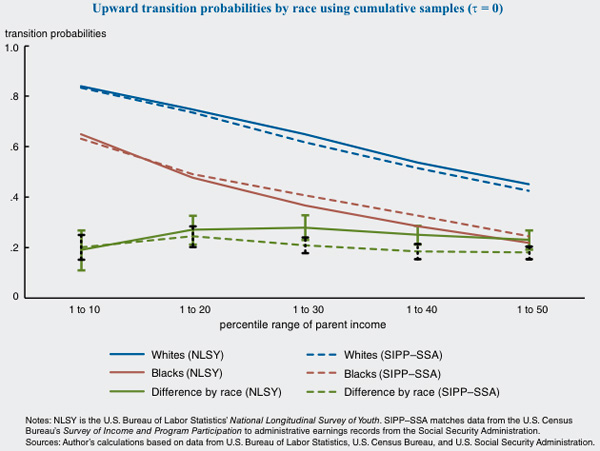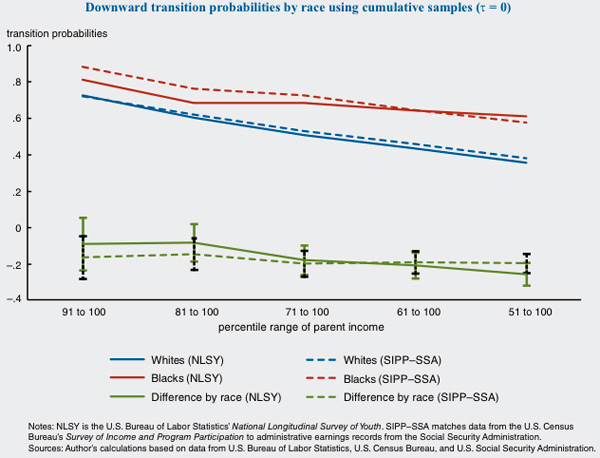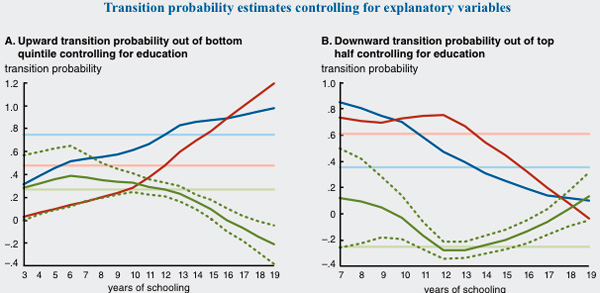Amidst all the attention given to inequality in recent months, much of it can be traced to six degrees of economists—Thomas Piketty, whose remarkably bestselling Capital in the 21st Century is a regular co-author and fellow creator of the World Top Incomes Database with Emmanuel Saez, who started the Equality of Opportunity project with 2013 John Bates Clark winner Raj Chetty. Before Capital caused such a stir, it was Chetty in the spotlight, with a paper (co-authored with Saez) demonstrating that intergenerational mobility in the U.S. hasn't actually changed that much.
Good news? Not entirely, as John Cassidy explains. On one hand, hey, not worse. On the other, it means that old and dramatic inequalities are running along the same tracks. "The Horatio Alger myth is still a myth," Cassidy writes. "Relative to many other advanced countries, the United States remains a highly stratified society, and most poor kids still have few prospects of making big strides."
In a recent Chicago Fed report, senior economist Bhaskar Mazumder looks at similar data with a focus on race. From Chetty's findings, you'd expect racial gaps in mobility to persist, and that's exactly what Mazumder finds.

This is a portrait of how likely you are to move up to a higher income decile than your parents, depending on how much money your parents make. A "transition probability" over .5 gives you better than a coin flip's chance of moving up the ladder. For both whites and blacks, they're more likely than not to move up from the lowest income decile, and the gap is lower. But once you move into the second decile, the gap increases—a curious inflection point. As Mazumder writes:
Among white men and women (solid blue line) whose parents’ income was at or below the 10th percentile, 84 percent exceed the 10th percentile as adults. As we move to the right and gradually increase the percentile range of family income, the upward transition probabilities fall. For example, among whites starting below the 40th percentile in the parent generation only 54 percent exceed the 40th percentiles as adults. In all cases, the comparable UTP estimates are much lower among blacks (solid red line). For example, among blacks starting in the bottom decile, only 65 percent exceed the bottom decile as adults, a 19 percentage point difference compared with whites. The black–white gap in the probability of rising out of the bottom quintile (solid green line) is even higher at 27 percent.
Now let's look at downward transition:

Again, an odd inflection point, this time at the top of the income scale (for the details on the difference betwen NLSY and SIPP-SSA, see the paper). Downward transition is high, at least in part because marginal gains at the top of the scale are going to be harder. But the gap increases below that highest decile—upper-middle and middle-class whites, broadly speaking, are more likely to lock in income gains. Mazumder describes the aggregate effect: "For example, about 60 percent of blacks whose parents were in the top half of the income distribution fall below the 50th percentile in the subsequent generation. The analogous figure for whites is 36 percent." As Mazumder concludes, echoing Cassidy, at current trends, the mobility gap isn't going to narrow.
What's going on? That's outside the scope of Mazumder's piece. But some of his other findings, I think, give a hint—and outline much more surprising racial differences.

For whites, the returns to schooling (or lack thereof) change pretty consistently with the amount of schooling. For blacks, there's a big inflection point around 12 years of schooling. And as Mazumder writes, "among those with 16 years of schooling, the racial gap in [upward] mobility is essentially closed. Nevertheless, the racial gap is still quite large among those with some post-secondary education who have not completed college." (I've written before about how the attention given to getting students through college is starting to catch up to the attention given to getting students into college, largely because of findings like this.)
For downward probability, the gap closes at 17 years or more of schooling. What it seems to suggest is that gaining upward mobility and avoiding downward mobility requires more educational attainment for blacks than it does for whites. Why that is remains, again, outside the scope of Mazumder's paper, much less this post, though he gives a couple brief suggestions (James Heckman's findings, for instance). But it's an interesting alternate look at mobility that complicates it with the intersection of race and education.




